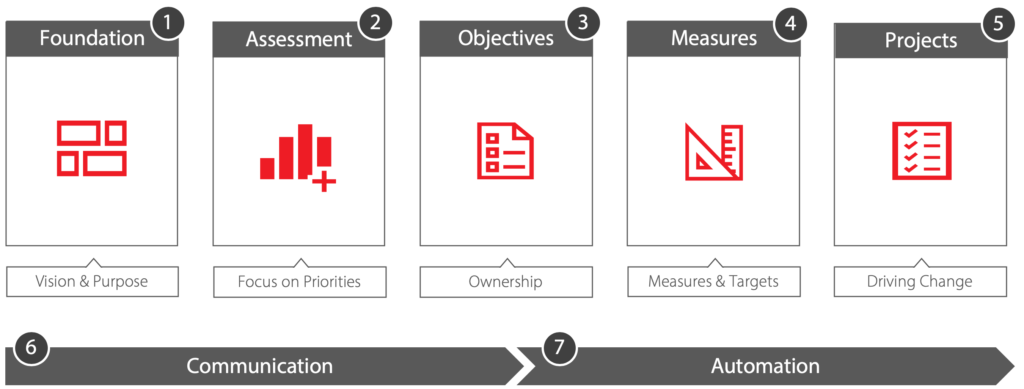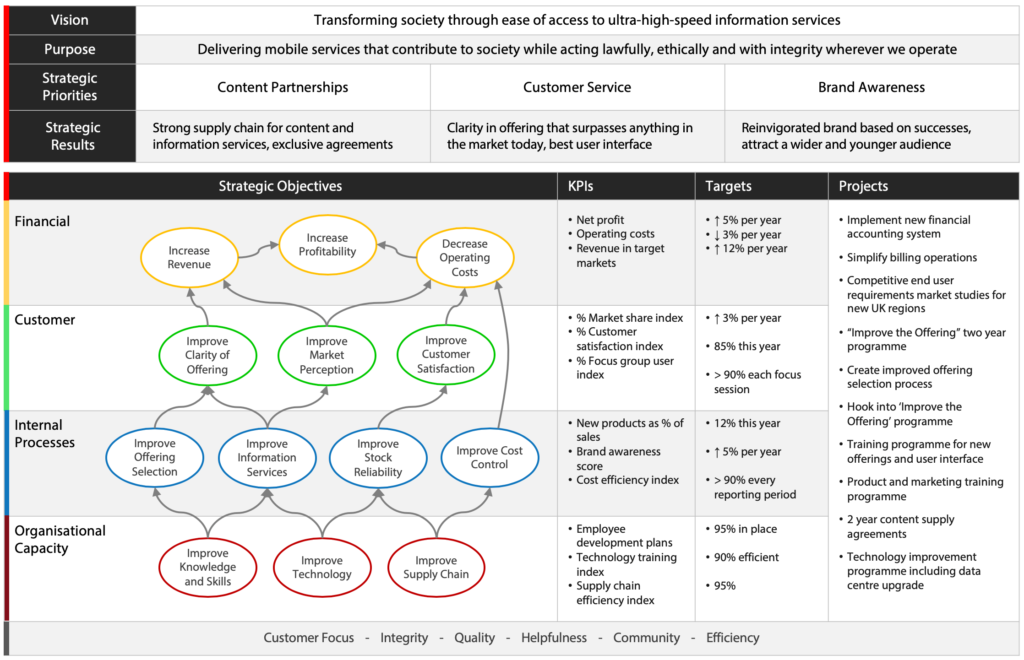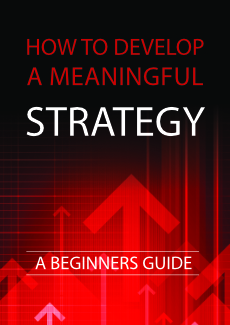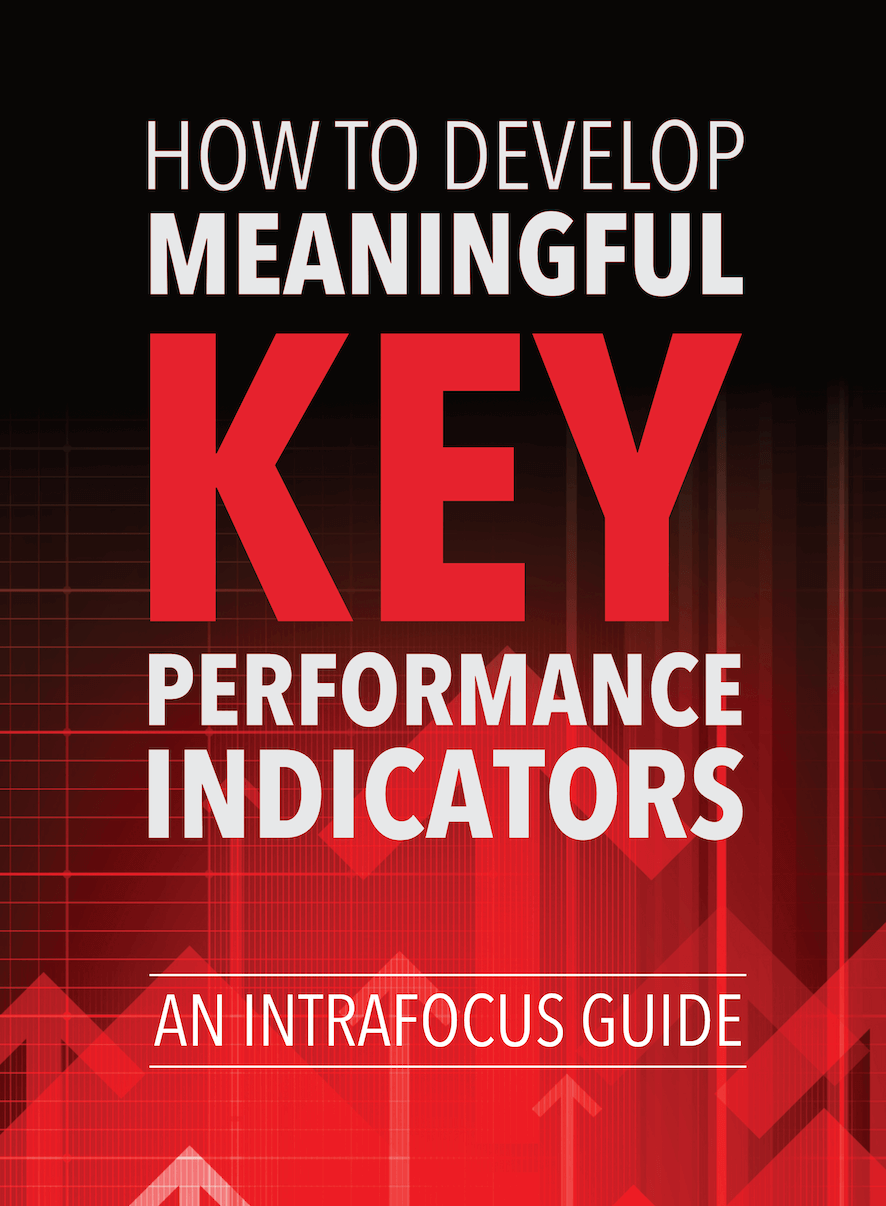Strategy Resources
Strategic Planning 101Let us help you demystify strategic planning
Strategic Management
Strategic management is a process. Just like any other operational process. The planning, implementation, monitoring and assessment of a strategy has to be defined as a series of tasks undertaken in a specific order. And just like a process, plans have to be in place to deal with exceptions. It is imperative that an organisation defines its strategic process. Or better still utilises an existing tried-and-tested universal process. Whether bespoke or off the shelf, a strategic process will usually be made up of seven steps:
- Foundation (Vision/Purpose/Core Values)
- Assessment (Strategic Priorities)
- Strategic Objectives
- Measures and Targets
- Projects and Actions
- Communication and Ownership
- Automation
If each of these steps are undertaken correctly then a strategy should succeed. Easier said than done. As with many complex structures that are defined simply, it is the interpretation of the model that can cause confusion and result in failure.
The Long-Term View
Strategic management is about taking a long-term view. As opposed to ‘tactics’ which centre on short-term gain. Nowadays, strategy and tactics often get mixed as technological advances have caused the ‘strategic cycle’ to condense. Where in the past a strategic outlook might have been 5-10 years, today it is usually more like 1-3 years (with a ‘nod’ to the future). Clearly, this view is industry dependent. In pharmaceuticals, for example, there is still a need to take a long-term view when producing drugs. However, in the high-tech industries, for example, mobile phones, new models become available every year which can force a quick change of direction.
A company, organisation or government needs to plan for the future, communicate, implement, monitor and modify the plan continuously. The last two parts of this process are usually poorly executed or missed entirely. A strategy is a living thing. It is not an activity that takes place once a year and forgotten.
There is a well-known industry statistic that is often misquoted; ‘90% of strategies fail.’ The real statistic is; ‘90% of strategies fail in execution.’ The strategies are usually very good. Time and patience has usually been put into developing, documenting and communicating the strategy. At the time of development, everyone has signed up and agrees that the strategy is sound and should be put into action. However, the strategy is put on the shelf until the following year, is dusted off and used for input into the next years round of activity. The strategy needs to be embedded into the normal day-to-day working of the organisation. To do this, a process has to be followed.
Strategic Tools
There are several ‘strategic mnemonics’ in use that are NOT strategic management processes, they are tools. For example, when asked what strategic process was being used in a particular company, the answer PESTLE was given. PESTLE is a useful tool, especially when applied to step two above, but it is not a strategic management process. A distinction must be made between a strategic ‘tool’ and a strategic ‘process‘. For a list of recognised strategic tools, go to the Strategic Analysis section of our Strategic Guides.
A recognised strategic process will put the detail behind the steps required to build, implement, monitor and evaluate a strategy. Some refer directly to the seven steps above, some use different terminology. Many companies/organisations have taken it upon themselves to create their own strategic process. We would not recommend this. You may think you are unique or that you want to develop a competitive edge by doing things differently. However, we are talking about a process here, it is the content that will make or break the strategy. Not reinventing the process. Recognised strategic processes have been tried and tested for years, often decades, and have proven track records of success. We recommend a Seven-Step Strategic Process that is based on the principles of the Balanced Scorecard methodology.
Off-The-Shelf Strategic Processes
Strategy Diamond
Published in the 2001 edition of The Academy of Management Executive by Professors Donald Hambrick and James Fredrickson. The Strategy Diamond identifies and elaborates upon five elements of strategic management with a question related to each:
- Arenas: where will we be active?
- Vehicles: how will we get there?
- Differentiators: how will we win in the marketplace?
- Staging: what will be our speed and sequence of moves?
- Economic logic: how will we obtain our returns?
The interesting thing about this process is that it is not a ‘process’ at all. The authors say:
“We do not mean to portray strategy development as a simple, linear process. The key is not in following a sequential process, but rather in achieving a robust, reinforced consistency among the elements of the strategy itself.”
For some organisations, this loosely linked set of activities (all of them need to be completed) may suit their culture, for others a more disciplined approach is required.
Blue Ocean Strategy
It must be said that Blue Ocean Strategy is a set of tools leaning towards the first three steps described in the basic process above. However, in the expanded edition of W. Chan Kim and Renee Mauborgne’s best-selling book of the same name, they begin to move into steps four, five and six as well. The book is supported by a huge internet resource base offering multiple helpful tools and guidance.
The authors say, “Blue Ocean Strategy represents a systematic approach to making the competition irrelevant and outlines principles and tools any organisation can use to create and capture their own blue oceans”
Blue Ocean Strategy should be considered in any strategic approach. It may be lacking as an overall strategic process at the moment, but the success of the approach is undeniable. In time the back-end of the process may well be added as well. In the meantime, the tools used could be integrated into the Strategy Diamond (above) or the Balanced Scorecard (below).
Objectives and Key Results
OKRs first hit business headlines in 1999, when Google used them to grow from an employee base of 40 to more than 60,000 people. Since then, OKRs have been publicly adopted by a number of leading tech firms, including Twitter, Spotify, LinkedIn and Airbnb. They have also moved into mainstream business usage, with big firms such as Walmart, Target, The Guardian, Dun & Bradstreet and ING Bank now on board.
For a full description of OKR’s go to our Objectives and Key Results page.
Balanced Scorecard
The Balanced Scorecard is a full end-to-end, step-by-step strategic process. Developed by Drs Kaplan and Norton over 20 years ago and re-developed later into an integrated strategic planning system by the Balanced Scorecard Institute. According to the Balanced Scorecard Institute: “More than half of major companies in the US, Europe and Asia are using balanced scorecard approaches. A recent global study by Bain & Co listed balanced scorecard fifth on its top ten most widely used management tools around the world, a list that includes closely-related strategic planning at number one. Balanced Scorecard has also been selected by the editors of Harvard Business Review as one of the most influential business ideas of the past 75 years.”
The fundamental feature of the Balanced Scorecard is the treatment of an organisation when viewing strategy. It sets out a ‘balanced’ view creating ‘Perspectives’ that look at Financial, Customer, Internal Processes and Organisational Capacity. The ‘Nine Step’ process created by the Balanced Scorecard Institute, and described in their book, The Institute Way, provides not only the detail but real examples of how the process has been implemented by companies and organisations around the world.
The output of the Blanced Scorecard Methodology can be seen quite clearly in the integrated Strategy Map below:
Conclusion
Strategy is about taking the long-term view and creating and communicating a way forward for an organisation. More than this, it is about putting in place a strategic process to ensure the strategy is implemented successfully and monitored continuously. A strategy is a living thing, it must become part of the day-to-day, week-to-week and month-to-month business process.




